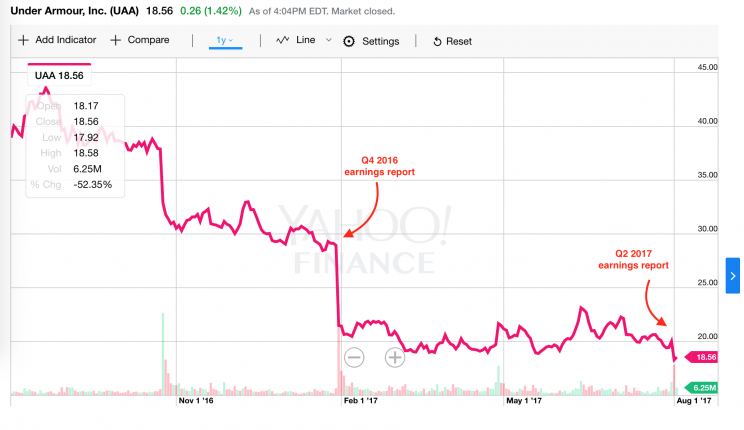Under Armour's business will get worse before it gets better
Less than a year ago, Under Armour reported its 26th consecutive quarter of at least 20% revenue growth.
That streak ended with its Q4 2016 earnings in January. And now, after its Q2 2017 earnings report this week, the party is clearly very over.
Under Armour “won’t return to 20% growth,” says sports retail analyst Matt Powell of NPD Group, “but it was naive to think that that trend would continue.”
The once-hot apparel brand reported a loss of $12 million for Q2 (3 cents per share); it announced layoffs (280 people, or 2% of its workforce); it lowered guidance for its 2017 full-year revenue growth; and it publicly acknowledged, “We’re pivoting.”
Can Under Armour possibly turn things around?

Yes, but it will take quite a while.
Amidst all the doom and gloom, it’s important to note that Under Armour boasts an all-star roster of sponsored athletes and a strong brand image—an image that is hurting it amidst today’s sports fashion trend, but an obvious, distinct image nonetheless—and that’s not going to just die.
“They have a great brand and a company of talented people,” says Powell. “They are suffering… but can pivot to sportswear under [new COO] Patrik Frisk’s leadership.”
Pivoting is never easy. The Baltimore brand’s growing pains will likely get worse before they get better.

First, Under Armour will go through the cost restructuring plan it promised shareholders this week, and that will involve spending money in 2017 to save money in 2018.
Under Armour expects to spend an estimated $110 to $130 million in “restructuring and related charges”: $45 million of that will be “severance and benefits costs” and “contract termination” charges, meaning severance packages for laid-off workers; $25 million in “facility and lease terminations,” meaning that Under Armour will close brick-and-mortar properties; and the rest will be costs related to inventory liquidation and other “intangibles.” Ouch.
Add to that the fact that industry-wide trends aren’t looking up any time soon: the march of brick-and-mortar sporting goods bankruptcies in North America has hurt all the big brands, but Under Armour especially, because 78% of Under Armour’s revenue comes from North America. And analysts do not expect the brick-and-mortar landscape in North America to improve in 2017.
Then there’s performance basketball sneakers. The category is down nearly 30% in 2017 so far, according to NPD Group data. Under Armour’s biggest footwear category is basketball and its biggest star athlete is basketball player Steph Curry. Kids have gravitated away from basketball shoes for everyday style, and toward trainers like the Adidas Boost line.
Under Armour footwear has to adapt, fast.
That goes for Under Armour’s apparel, as well. Its brand image has been: performance gear, for men, for playing sports. As the company said itself, it must pivot: “From predominantly men’s to distinct collections for men, women and kids,” and, “from US/mostly apparel centric to a global/apparel, footwear and accessories portfolio.”
The global part is actually going well: international revenues grew 57% in Q2, the lone bright spot in the earnings report.
But the task of pivoting to better accommodate women and kids, and to look more fashion-appropriate, will be painful.
But Under Armour can claw back. It just has to “develop more sportswear and less ‘sports’ wear,” as Powell puts it humorously. That is: make more general sportswear, that can be worn as fashion.
In other words, yes: athleisure.
—
Daniel Roberts is the sports business writer at Yahoo Finance. Follow him on Twitter at @readDanwrite.
Read more:
Under Armour: ‘We’re pivoting’
3 big reasons Under Armour has cooled off
Under Armour CEO: We have to be a premium full-price brand
Adidas blows investors away with stellar 2017 outlook
Under Armour, UCLA, and why the biggest college sports deal ever isn’t such a big deal
